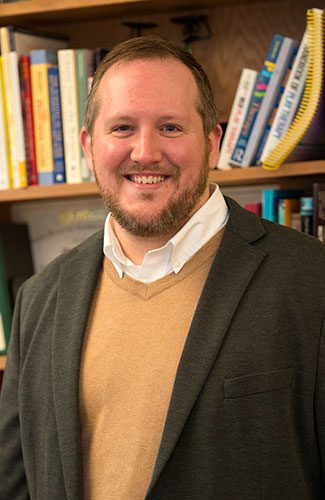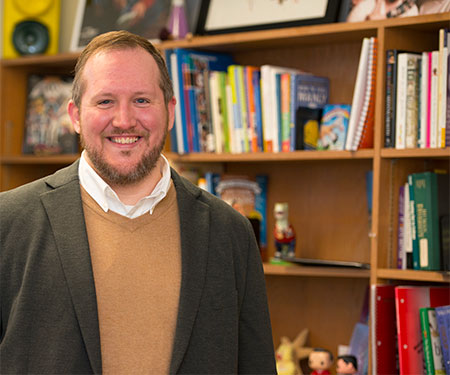
Numbers begin to tell the story.
Around two-thirds of children in the United States experience some form of trauma before the age of 16. Help for each could come in a 15-minute pull-out once a week at school with a trained counselor or, if finances allow, in a 50-minute session with a clinical mental health specialist.
Yet it’s teachers who are with those children for hours each day – and, for the second consecutive summer, it’s teachers who will come to the NIU College of Education to enhance their ability to incorporate trauma-informed practices into their work.
COUN 490/590: Trauma-Informed Concepts for Educational Settings provides critical knowledge and effective strategies for teachers, school counselors and other educational personnel.
Fully online and asynchronous, the course will take place from June 14 through Aug. 8 with eight modules that include video introductions, modeling of immediately applicable practices, relevant readings and “choose-your-own-adventure” assignments with varying levels of points.
By the fall, says Adam Carter, assistant professor in the Department of Counseling and Higher Education, those who’ve completed the curriculum will respond to situations rather than react to them.
“Teachers are the ones who are really on the front lines. It makes more sense for us to look at focusing our time and energy to help teachers get what they need in terms of meeting academic standards but also in helping children in that classroom environment,” Carter says, “making sure that what we’re doing to help them learn isn’t actually retraumatizing and revictimizing them during the process.”
Such a possibility lies in disciplinary procedures.
“When you think of behavioral modifications that a lot of schools still use, these interventions are usually connected to relationships in some way,” he says. “I don’t want to upset someone, and therefore I will avoid doing that behavior, and I will then do right instead.”
Yet a child who has experienced trauma is likely functioning “from the back part of the brain” and seeking safety and security.

“A child goes into a room, and the child is constantly scanning the room, and the child is hyper-aware, which may look like not being focused, which may look like, ‘Why can’t that child sit still?’ if the child’s getting up and constantly scanning the room to make sure they’re safe,” Carter says.
“So we’re going to put these behavioral interventions in place that say, ‘We want you to stop your body, and we want you to stop doing these things that your brain – your autonomic nervous systems, the part of your brain that you have no control over – is having you do. We want you to try to stop that, and if you can’t, then we’re going to put consequences in place,’ ” he adds.
“In essence, what we’re doing to this child who has experienced trauma – this child who is responding to their environment – is we’re saying, ‘Stop doing that, and if you can’t stop doing that, then we’re going to punish you.’ The child who has been traumatized is now being punished for responding to the trauma, and nowhere in there has the trauma actually been compartmentalized, and that’s what we need to be talking about, and not necessarily the child’s behavior.”
Carter hopes students in the course will become advocates able to effect change throughout the system.
For example, he says, consider a student who enters the classroom visibly upset. She slouches into a seat, head down and face bundled inside her hoodie.
An administrator is likely to deem that student’s behavior unacceptable: “That’s not OK. You can’t put your head down on your desk. You can’t cover your head. You have to engage from the moment you step in. You need to be ready to learn.”
Trauma-informed teachers, on the other hand, will understand to provide time and space.
 “I know that the best thing for this child, and the best thing for me in our relationship, is to give her those few minutes of regulating, of getting back on the page, of knowing that I’m a safe place for her to do that. If I do that for a few minutes, we’re both going to be successful. But if I go in and ‘poke the bear,’ and say, ‘Take your hood off. Sit up. I know you’re not in a place to listen,’ it would then escalate her, and she couldn’t regulate. No learning would take place.”
“I know that the best thing for this child, and the best thing for me in our relationship, is to give her those few minutes of regulating, of getting back on the page, of knowing that I’m a safe place for her to do that. If I do that for a few minutes, we’re both going to be successful. But if I go in and ‘poke the bear,’ and say, ‘Take your hood off. Sit up. I know you’re not in a place to listen,’ it would then escalate her, and she couldn’t regulate. No learning would take place.”
Carter would count that decision among the Tier 1 interventions always available to teachers – and, he adds, among the strategies that contribute to a flourishing classroom environment for all students.
Simple measures include predictability, “so that when a student comes in, they understand when you begin, what’s going to happen next what’s going to happen when it ends. For a child who’s experienced trauma, or is continuing to experience trauma, unpredictability contributed to dysregulation.”
Or, he says, tone of voice.
“If we can remove yelling from a paradigm of trying to get students’ attention, or raising voices to try to speak over them – we’ve got a lot of young folks who are triggered by raised voices, especially the raised voice of a male educator,” he says. “Whenever that voice goes up, the brain then says, ‘There’s a threat to protect against.’ ”
And, when that happens, a trauma-impacted child might react in a “fight” mode, which could make the room louder and even lead to confrontation, “as opposed to the students just falling in line and doing what’s supposed to happen.”
To make matters worse, Carter adds, a child responding to an adult’s yelling “is the one who’s going to have punishment, or have a phone call home and then get punished even more, and possibly being retraumatized at home.”
Such knowledge is helpful even during COVID-19 and the virtual learning it promoted.
Teachers should recognize that children might not have the best environment for learning at home, which could influence them to leave their cameras or microphones off: Punishing a child for that decision can trigger further trauma.
 Trauma-impacted children who enjoyed safety and solace at school might begin to behave inappropriately as their crisis levels rise – or to alert their teachers about their situation in the only way they know that works.
Trauma-impacted children who enjoyed safety and solace at school might begin to behave inappropriately as their crisis levels rise – or to alert their teachers about their situation in the only way they know that works.
Meanwhile, it’s important to recognize that COVID-19 itself has compounded issues.
“We haven’t seen trauma numbers go down during the pandemic,” Carter says. “Our numbers are already pretty high – knowing that two-thirds of children ages 16 and younger, and upward of 70% of adults have experienced some type of trauma – and those numbers didn’t go down.”
For teachers, the abrupt switch to remote teaching and learning last March began with the expectation that they just find a way to survive – to do whatever they could to maintain momentum. By the fall, however, they again were asked to thrive despite the continued difficult circumstances.
Now, he adds, a return to fully in-person learning will present other challenges.
Some teachers haven’t needed to manage loud classrooms since last spring. Some high school sophomores or eighth-graders will arrive at their schools without any sense of the building layouts, including even the locations of the restrooms. Some students and staff won’t return at all, having lost their lives to the virus, while others are mourning loved ones.
Carter is cautiously optimistic.
“There are just some things that are not going to be the same for a while, and I pray that we don’t push through them too quickly,” he says.
“I pray that we don’t say, ‘It’s been a week. You should – ,’ and then fill in the blank. ‘You should be over this.’ ‘You should feel safe.’ We’ve told students and teachers for a year-and-a-half that it’s not super-safe to be close to folks, and if we open in September, and we’re putting people 25 or 30 to a room again, that won’t go off easily,” he adds.
 “We’ll still have that child who’s thinking, ‘Am I too close? What happens if I get sick? I have a family member at home who, if they get this, may die.’ All of these thoughts are still going to be there.”
“We’ll still have that child who’s thinking, ‘Am I too close? What happens if I get sick? I have a family member at home who, if they get this, may die.’ All of these thoughts are still going to be there.”
But, the professor says, the students with whom he engages this summer will bring the right tools to each situation.
“When you create relationships where children feel safe and feel as though they can thrive, then we increase the chances of a child being able to say, ‘I may need help. I may need support, and I trust and acknowledge that you’re someone I can share this information with, and then I can get the help,’ ” Carter says.
“It’s the same thing with grief and loss,” he adds. “When we acknowledge and partner with them systemically to be able to not only process but to learn and live in that new space, test scores go up. Grades go up. Interactions with their peers go up. It’s not a theory. It’s proven.”

